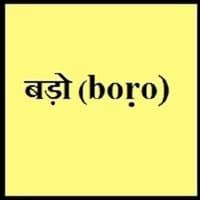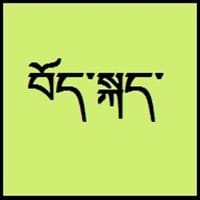Countries
Assam, India
China, Nepal
National Language
Assam, India
Nepal, Tibet
Second Language
Not Available
Not spoken in any of the countries
Speaking Continents
Asia
Asia
Minority Language
Not Available
China, India, Nepal
Regulated By
Not Available
Committee for the Standardisation of the Tibetan Language
Interesting Facts
- In ancient times, Bodo language was written using Assamese script and Roman script.
- Bodo Language is written using Devanagari script since 1963.
- Tibetan dialects vary alot, so it's difficult for tibetans to understand each other if they are not from same area.
- Tibetan is tonal with six tones in all: short low, long low, high falling, low falling, short high, long high.
Similar To
Dimasa language, Garo language, Kokborok language
Not Available
Derived From
Not Available
Not Available
Alphabets in
Bodo-Alphabets.jpg#200
Tibetan-Alphabets.jpg#200
Scripts
Devanagari
Tibetan alphabet, Tibetan Braille
Writing Direction
Not Available
Left-To-Right, Horizontal
Language Levels
Not Available
Time Taken to Learn
Not Available
Hello
Not Available
བཀྲ་ཤིས་བདེ་ལེགས། (tashi delek)
Thank You
Not Available
ཐུགས་རྗེ་ཆེ་། (tujay-chay)
How Are You?
Nungni khabora ma?
ཁྱེད་རང་སྐུ་གཇུགས་བདེ་པོ་ཡིན་པས།
(kayrang kusu debo yimbay?)
Good Night
मोजां हर (Mwjang Hor)
གཟིམ་ལཇག་གནང་དགོས་། (sim-jah nahng-go)
Good Evening
Not Available
དགོང་དྲོ་བདེ་ལེགས།
Good Afternoon
Not Available
ཉིན་གུང་བདེ་ལེགས།
Good Morning
मोजां फुं (Mwjang Fung)
སྔ་དྲོ་བདེ་ལེགས། (nga-to delek)
Please
अननानै (Onnanwi)
thu-je zig / ku-chee.
Sorry
Not Available
ཀོང་དགས་། (gawn-da)
Bye
Not Available
ག་ལེར་ཕེབས་། (kha-leh phe)
I Love You
अननाइ नों (onnai Nwng)
ང་ཁྱེད་རང་ལ་དགའ་པོ་ཡོད་ (nga kayrâng-la gawpo yö)
Excuse Me
Not Available
དགོངས་དག བཟོད་དུ་གསོལ། ཐུགས་རྗེ་གཟིགས།
Dialect 1
(Sønabari) Western Boro dialect
Central Tibetan
Where They Speak
Bongaigaon, Kokrajhar
China, India, Nepal
How Many People Speak
Not Available
Dialect 2
(Sanzari) Eastern Boro dialect
Khams Tibetan
Where They Speak
Barpeta, Darrang, Kamrup, Nalbari
Bhutan, China
How Many People Speak
Not Available
Dialect 3
(Hazari) Southern Boro dialect
Amdo Tibetan
Where They Speak
Assam, India, Nepal
China
How Many People Speak
Not Available
Speaking Population
Not Available
Not Available
Native Name
बड़ो (boṛo)
བོད་སྐད་ (pö-gay)
Alternative Names
Bara, Bodi, Boro, Boroni, Kachari, Mech, Meche, Mechi, Meci
Bhotia, Dbus, Dbusgtsang, Phoke, Tibetan, U, Wei, Weizang, Zang
French Name
Not Available
tibétain
German Name
Not Available
Tibetisch
Pronunciation
[bɔɽo]
Not Available
Ethnicity
Bodo, Mech, (Assamese)
tibetan people
Language Family
Sino-Tibetan Family
Sino-Tibetan Family
Subgroup
Tibeto-Burman
Tibeto-Burman
Branch
Not Available
Not Available
Early Forms
Not Available
Old Tibetan, Classical Tibetan
Standard Forms
Not Available
Standard Tibetan
Signed Forms
Not Available
Tibetan Sign Language
Scope
Individual
Not Available
ISO 639 1
Not Available
bo
ISO 639 2/T
Not Available
bod
ISO 639 2/B
Not Available
tib
ISO 639 6
Not Available
Not Available
Glottocode
bodo1269
tibe1272
Linguasphere
Not Available
No data Available
Language Type
Living
Not Available
Language Linguistic Typology
Not Available
Not Available
Language Morphological Typology
Not Available
Not Available
Bodo and Tibetan Greetings
People around the world use different languages to interact with each other. Even if we cannot communicate fluently in any language, it will always be beneficial to know about some of the common greetings or phrases from that language. This is where Bodo and Tibetan greetings helps you to understand basic phrases in Bodo and Tibetan language. Bodo word for "Hello" is Not Available or Tibetan word for "Thank You" is ཐུགས་རྗེ་ཆེ་། (tujay-chay). Find more of such common Bodo Greetings and Tibetan Greetings. These greetings will help you to be more confident when conversing with natives that speak these languages.
Bodo vs Tibetan Difficulty
The Bodo vs Tibetan difficulty level basically depends on the number of Bodo Alphabets and Tibetan Alphabets. Also the number of vowels and consonants in the language plays an important role in deciding the difficulty level of that language. The important points to be considered when we compare Bodo and Tibetan are the origin, speaking countries, language family, different greetings, speaking population of these languages. Want to know in Bodo and Tibetan, which language is harder to learn? Time required to learn Bodo is Not Available while to learn Tibetan time required is 24 weeks.





